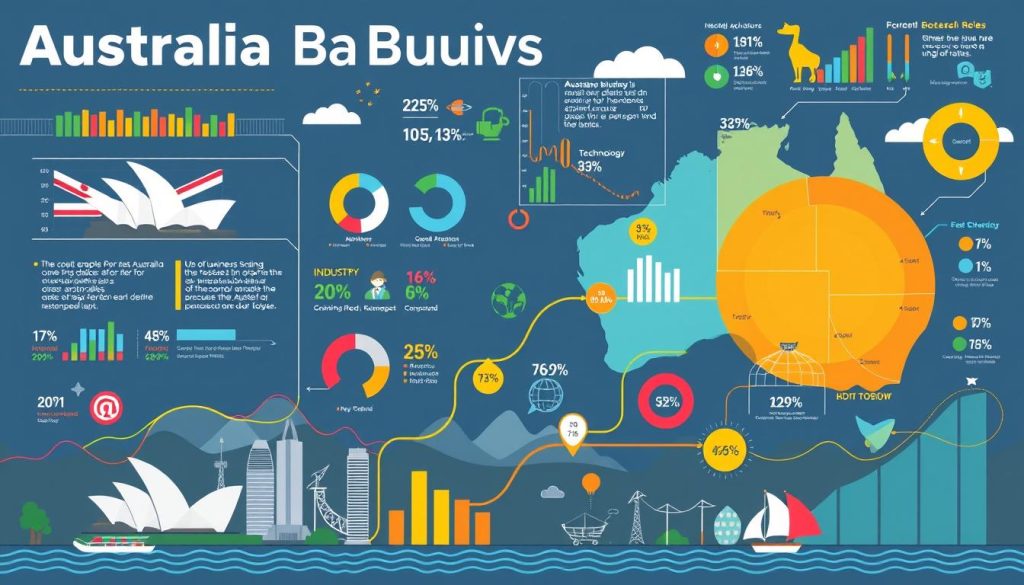Exploring structural business statistics in Australia reveals a complex and dynamic Australia business landscape. These statistics offer deep insights into the economic performance and operations of businesses across the country. They help us understand how businesses have evolved from March 2013 to June 2024, highlighting productivity, sectoral contributions, and regional impacts.
About 73% of Australian businesses conduct market research to understand their customers and competitors better. This shows their dedication to meeting market demands. With 56% seeing market research as crucial for their marketing strategies, it’s clear that making informed decisions is key to business growth.
The Australian business sector’s resilience is evident in its ongoing investment in research and analysis. A staggering 85% of businesses advocate for continuous market research in their operations. This article aims to give a detailed look at the enterprise dynamics that shape our economy. It aims to deepen our understanding of the factors driving success in the Australian business environment.
Overview of Business Landscape in Australia
The Australian business scene has seen a lot of change lately. The number of businesses has grown a lot. This shows our economy is adapting to both local and global issues.
The latest business statistics 2024 show there are about 2,663,000 businesses by June 2024. This is up from around 1,990,082 in March 2013. This growth shows our economy is moving forward, even when things get tough.
Growth in the Number of Businesses
Small businesses are key to our economy, making up about 97.3% of all businesses. Good policies have helped boost business growth Australia. More businesses mean more jobs and new ideas in different areas.
Comparison of Total Businesses from March 2013 to June 2024
In the last eleven years, Australia’s business scene has seen ups and downs. But, seasonal adjustments suggest a steady path. Recent data shows the economy has faced hurdles, yet it remains strong.
As we look towards business statistics 2024, we’re excited to see how things will unfold. How will these trends shape Australia’s economic future?
Structural Business Statistics in Australia
Understanding business dynamics is key to knowing the health of Australia’s economy. Recent data shows big changes in the number of companies and how they do. By 2024, Australia will have about 3,305,744 registered companies, up from 2,835,626 in January 2021. This growth shows how Australian businesses are changing and how entrepreneurs are adapting.
Understanding Business Dynamics and Their Significance
We look at how many companies start and stop to understand business trends. In 2022-23, 15.8% of companies started, with 406,365 new businesses. But, 15.0% of companies closed, with 386,392 shutting down. This shows the ups and downs of the business world.
Some sectors stand out in the business world. The construction industry is huge, thanks to more building and renovations. The healthcare and social assistance sector also grew by 6.1%, showing more people need these services.
These numbers help us see how businesses react to changes and demands. They help us spot trends and areas that will grow. This gives us a better view of Australia’s economic landscape.
Key Industries Driving Economic Output
Australia’s economy is driven by key sectors that play a big role. These sectors are the backbone of our economy, contributing a lot to our overall output. Each sector is crucial in shaping our financial health.
Sector Contributions to the Australian Economy
Health and Education lead with a 13.4% GDP contribution. Mining is close behind with 12.2%, showing its key role in our resources. Finance and Construction each contribute 7.5%, showing their importance.
These figures show how each sector performs and how they work together. The health of one sector can impact others.
Industry Share of Output Across Key Sectors
The output from these industries shows Australia’s financial health. Mining’s focus on resource management boosts exports, making up 60.1% of our exports. This is crucial for managing economic dependencies and diversifying.
In 2024, our GDP hit $1.802 trillion. This highlights the role of sectors in reaching our economic goals.
Business Growth by Region
Looking at business growth by region helps us see how Australia’s economy works. Each state plays a unique role in the economy. This shows us how jobs and output change across the country.
Output Share by State
New South Wales leads with 30.3% of the country’s output. Victoria follows with 22.2%, and Queensland has 19.7%. This shows how each state’s economy is strong in different ways. For example, mining boosts growth in states with lots of natural resources.
Regional Contributions to Employment and GDP
States are key in creating jobs. New South Wales and Victoria have strong economies that support many jobs. Small businesses alone employ over 5.1 million people. This shows a solid base for economic stability.
Looking at GDP by region helps us spot where the economy might grow. This is important for finding new economic centres.

By studying state data, we learn a lot about Australia’s economy. This helps us make plans to grow the economy. It supports both new and existing businesses, aiming for long-term financial success.
Export Trends and Economic Implications
Understanding Australian export trends is crucial for our economy. A big part of our exports is resources, making up about 60.1%. China and Japan are our main buyers, taking up 32.4% and 13.1% of our exports. This shows we need to look at our exports and their impact on the economy.
Export Share by Type
Resource commodities dominate our exports. As global demand changes, this is key to consider. We might need to focus more on manufactured goods and services to be more stable.
Major Export Destinations and Their Impact on the Economy
China and Japan are big for our economy. Changes in demand from them can affect our trade balance and economy. Keeping an eye on these markets helps us plan better for economic changes.
Employment Trends and Workforce Dynamics
Looking at employment trends in Australia gives us a clear view of our labour market’s current state and future. The employment-to-population ratio is 64.4%, showing how the economy uses its working-age people. This ratio shows the health of the economy and industries.
Employment to Population Ratio Analysis
The employment-to-population ratio has grown over 30 years, showing more jobs match the workforce. Australia aims to keep inflation low while boosting employment. This shows the need for a strong economic plan.
Changes in the job market and monetary policy help us understand full employment. They also affect job seekers.
Impact of Industry Growth on Employment Opportunities
Our analysis shows big changes in certain industries like Health, Education, and Technology. These areas are creating more jobs quickly. With 71% of companies planning to grow their teams, we expect more job openings.
But, 31% of companies might lay off workers, showing the need for flexible workforce policies. Offering competitive salaries and matching job roles with industry standards will help keep talent.

Financial Health of Australian Businesses
The financial health of Australian businesses is key in today’s complex economy. Recent data shows a big jump in EBITDA, from AUD 222,678 million in 2021-2022 to AUD 274,676 million in 2022-2023. This rise means many companies are making more money from their work.
But, some sectors like retail and hospitality are facing tough times. Lower spending by consumers means less demand and higher costs. With the end of pandemic aid, some businesses are struggling again, showing the need to watch their finances closely.
Australian businesses need smart risk management to stay afloat. This includes better relationships with suppliers and managing cash flow well. Using financial ratios and cash flow analysis helps us understand how well companies are doing. Knowing the challenges of being far away and having a small market is crucial for keeping businesses financially healthy.

